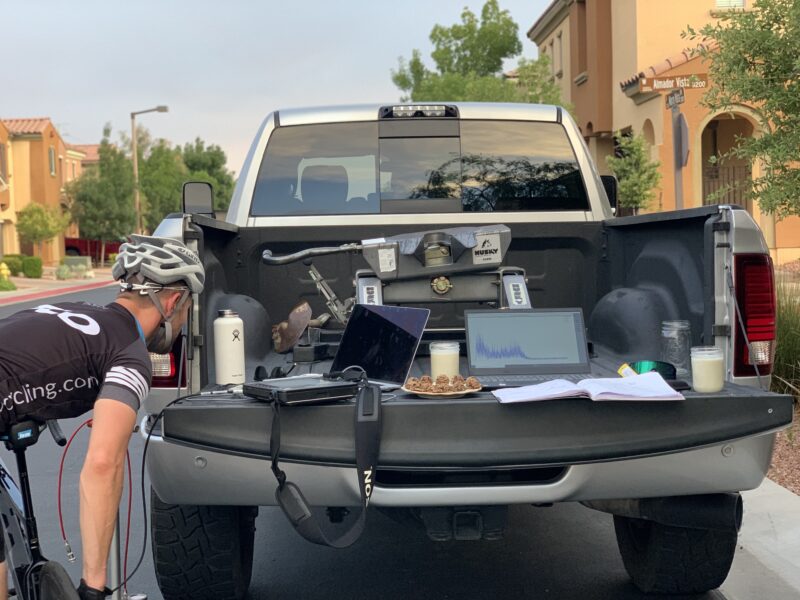We’ve written a lot about vibration and cycling wheels on this blog. Two key articles were about natural frequencies and how vibration transfers to the cyclist. Both of these articles were heavy on the science. If you want to learn about both in detail I invite you to read them. This article will explain the main things you as a cyclist must know about vibration and how to make yourself a faster athlete.

Natural Frequency (aka Resonance) in Cycling
To fully understand the three things every cyclist needs to know about vibration we are going to cover a little background. Every physical object has a natural frequency. For example, let’s assume we have three tuning forks with their own natural frequencies.
Tuning Fork A – 440 Hz
Tuning Fork B – 512 Hz
Tuning Fork C – 440 Hz
If you bring Tuning Fork B near Tuning Fork A and tap it with a hammer nothing happens to Tuning Fork A. However if you bring Tuning Fork C near Tuning for A and tap it, Tuning Fork A vibrates without being touched by the hammer. This YouTube Short shows an example.
How does this relate to a cyclist? Good question. Road surfaces are not smooth and add broad-spectrum vibration to a cycling wheel as it rolls. Broad-spectrum vibration refers to a range of frequencies. In road cycling the range induced by the road is roughly 0 Hz-160 Hz.
Tires/wheels are the first contact with the road surface and a wheel and tire have a natural frequency. Since the natural frequency of a tire/wheel is between 0 Hz – 160 Hz the broad spectrum vibration from the road excites the wheel and will vibrate just like when Tuning Fork A was close to Tuning Fork C when it was tapped with the hammer.
Excess vibration is normally produced when a tire is inflated above its impedance break point. When this happens your wheels along with you and your bike vibrate in the x, y, and z directions. The important one to consider is the Z-direction means up and down. More on this below.
Now, here are the three things every cyclist must know about vibration.
Vibration Need to Know 1: Vibration Makes You Slower
When you add excess vibration to a cycling wheel that vibration transfers to the bike and you the cyclist. This makes you slower in two key ways.
- When you are vibrating up and down in the Z-direction, energy is wasted moving you up and down instead of moving you forward. How much? Well, about 1 psi for every watt you are over the impedance break point. It’s a big deal.
- Excess vibration in your body produces micro tears in your muscles leading to premature fatigue during a long race. Also, not good.
Vibration Need to Know 2: Vibration Reduces Your Grip and Steering
When you are vibrating up and down in the Z-direction you are essentially bouncing down the road. Think of the small bumps in the road like little jumps. Each upward movement reduces your weight on the bike and shrinks the contact patch your tire makes with the road. When the contact patch is smaller your grip on the road is less. This makes handling more difficult and creates the possibility of losing it on a corner. This is especially important in gravel. Gravel also introduces the swimming of the front wheel when vibrating is too high. If you’ve ever ridden on gravel when vibration is not managed you’ll know that your front wheel swims left and right as you ride.
If this is difficult to understand consider this extreme example. If you are unweighted enough to get air you have no grip with the road. A smaller contact patch creates less friction since it’s smaller and the weight is reduced.
Vibration Need to Know 3: You Can Manage Vibration With Two Things
The good news here is that vibration can be managed. When managed you’re faster, reduce fatigue, and maintain maximum grip on the road surface. Here are the two ways to manage vibration as a cyclist.
- Wheels: A good wheel is designed to reduce vibration. We’ve been incorporating vibration management into our wheels for nine years. The side walls of a carbon rim will act like a leaf spring when designed properly. Get a good wheel and you’ll be set.
- Tire Pressure: Most people think that managing tire pressure helps them reduce rolling resistance. While this is true it’s not the only benefit. When you keep your tire pressure below the impedance break point you greatly reduce the vibration in the wheel which eliminates the negatives mentioned above. We have tire pressure charts for all our wheels and created the FLO Air Gauge to give you the most accurate air pressure. Most pumps can be off by as much as 9 psi which means you can lose 9 watts and not even know it.

Final Thoughts
While vibration has become somewhat of a buzzword in the last couple of years we’ve been thinking about it for a long time and finding ways to make athletes faster. If you want to talk through vibration management stately please feel free to book a Wheel 1 on 1 and we will help you out.

Co-founder at FLO Cycling. Jon manages the day to day operations and acts as the lead engineer for all FLO products.
